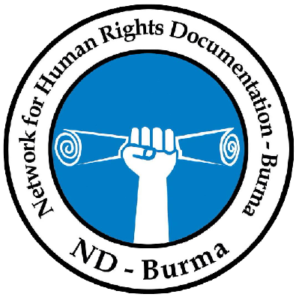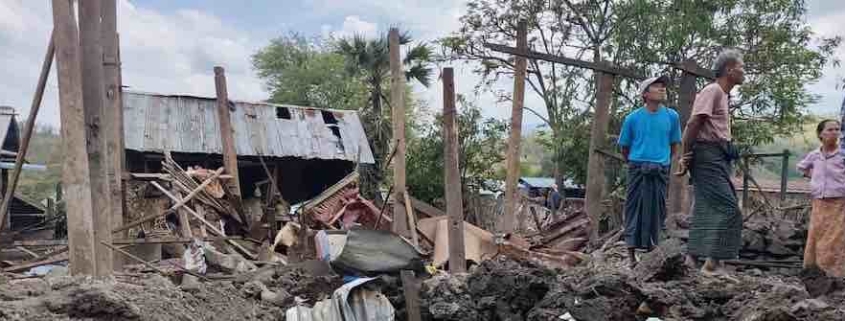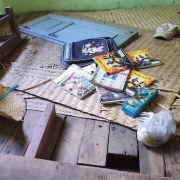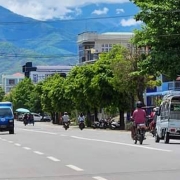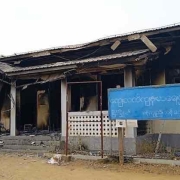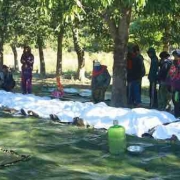Sagaing Aftershock, Airstrikes, and a Humanitarian Collapse
Antonio Graceffo
According to propaganda from Chinese state media and Burma’s junta-controlled outlet, The Global New Light of Myanmar, post-earthquake debris clearance is reportedly progressing rapidly, with 80% completion claimed in Mandalay and 50% in Sagaing. But the reality on the ground tells a different story: millions remain exposed to displacement, searing heat, early monsoon rains, rising disease outbreaks, and a severe lack of shelter, food, and medical care.
More than a month after the 7.7-magnitude twin earthquakes struck central Burma on March 28, the country is spiraling deeper into crisis. Over 3,800 people were killed, more than 11,000 injured, and at least 55,000 homes destroyed or damaged across multiple regions, including Sagaing, one of the hardest-hit areas. Families already displaced by four years of civil war now find themselves living in makeshift shelters, with little protection from the elements and no reliable access to health or sanitation services.
The United Nations estimates that 6.3 million people are in urgent need, and nearly 20 million, over one-third of the population, require humanitarian assistance. Yet of the $275 million requested under the UN’s earthquake response plan, just $34 million has been received, only 12 percent of the total. Relief efforts remain drastically underfunded and unable to meet the scale of need, particularly in areas like Sagaing, where the junta has severely restricted access to international aid.
Despite publicly declaring a ceasefire to facilitate relief, the military regime has instead intensified its attacks. Since the earthquake, the junta has launched at least 243 assaults—including 171 airstrikes, killing more than 200 civilians, according to the UN. These continued strikes, coupled with a blockade on international aid, have transformed a natural disaster into a man-made humanitarian collapse, placing civilians and humanitarian workers at further risk.
Aid efforts remain drastically underfunded and insufficient. Humanitarian agencies have reached just 600,000 people with clean water, 500,000 with food, and only 100,000 with emergency shelter—nowhere near enough given the scale of need. Over 450,000 people require urgent medical care, yet only 33,600 have been reached. Delayed rubble clearance has created mosquito breeding grounds, increasing the risk of malaria, dengue, and cholera in nine high-risk townships across quake-affected zones. Without immediate funding and full access, aid workers warn that thousands more lives remain in jeopardy.
While the entire country has been shaken by disaster, nowhere is the crisis more acute than in Sagaing. Even before the earthquake, the region was already among the most fragile in Burma, racked by four years of war, mass displacement, and economic collapse. Nearly 1.3 million internally displaced people were already sheltering in the region, many having fled repeated waves of violence. The local economy had cratered: over 40% of households reported income loss in 2023, and 74% were living below the minimum expenditure threshold. Food insecurity had reached crisis levels, with rice prices rising 214% since 2021 and a 19% drop in cultivated farmland due to conflict and displacement. Essential services like education and healthcare had collapsed, 56% of children were out of school, and Sagaing had the highest rate of unmet healthcare needs in the country.
The earthquake pushed this already dire situation into full collapse. Weakened infrastructure was destroyed or rendered unusable. With only 35% of the population having internet access and frequent power outages, communication, remote education, and emergency coordination remain severely limited. Women and girls face heightened risks of gender-based violence, trafficking, and social exclusion, particularly in overcrowded displacement camps.
Youth face an especially bleak future. With schools closed, jobs vanished, and communities destabilized by war, many young people are trapped in a cycle of fear and uncertainty. Some have joined the armed resistance, while others fall into dangerous informal labor. Even before the quake, over 78% of youth reported stress or anxiety driven by economic hardship and political instability. With education interrupted and trauma ongoing, an entire generation risks being left behind, under-skilled, disconnected, and psychologically scarred.
At the same time, Sagaing’s environmental crisis has worsened. Located in the heart of Burma’s Dry Zone, the region regularly faces extreme heat, with temperatures reaching a record 48°C in 2024. Deforestation and erratic rainfall have intensified riverine flooding, particularly along the Chindwin River, with some townships losing over 40% of their forest cover since 2021. Illegal gold and rare earth mining operations have poisoned rivers, degraded farmland, and accelerated displacement. The result is an ecological collapse makes Sagaing one of the most climate-stressed and conflict-afflicted regions in the country.
Since the quake, conditions on the ground have only deteriorated further. In Sagaing Township, survivors continue to sleep outdoors, as aftershocks and structural damage have rendered buildings unsafe. Meanwhile, the junta has continued its bombing campaign, now increasingly relying on paramotor aircraft, or motorized paragliders, to carry out strikes in place of aging jets. Between March 28 and April 24, Myanmar Witness documented at least 24 attacks in Sagaing, the highest number in the country.
On April 1, the Indaw Myoma Monastery in Wuntho Township was bombed, killing two civilians. On April 9, Nan Khan village tract was hit twice in a single day, reportedly killing more than 20 civilians, including children. Between April 8 and 19, a resistance fighter from Kani Township recorded 31 airstrikes, including 24 in a single day on Thingyan Ah Kya day, targeting monasteries, homes, a school, and a cowshed. On April 23, another strike on Let Hloke village in Tabayin Township killed five civilians, among them a 13-year-old girl and an 80-year-old woman. These attacks underscore that for many in Sagaing, the earthquake was not the end of the suffering, but the beginning of something even worse.
Unless the international community applies real pressure on the junta and dramatically scales up unrestricted aid, Sagaing’s survivors will continue to suffer, not only from the aftermath of the earthquake that destroyed their homes, but from the military government and the civil war that continues to crush their lives.
The junta’s ongoing bombing campaign, refusal to allow unimpeded aid, and targeting of civilians, even after declaring a ceasefire, have turned the earthquake into a man-made collapse. UN Human Rights Chief Volker Türk warned that “humanitarian aid must be able to reach those in need without impediment,” and that the military must stop “futile investment in force” and commit to “a genuine and permanent nationwide halt to hostilities.”
Burma needs more than temporary fixes. It needs the restoration of democracy and the rule of law. This earthquake could be the moment that finally draws global action. Or it could become just one more blow to a people ground into the earth by military rule, and one more failure of the international community to bring about real change.
Antonio Graceffo is an economist and China expert who has reported extensively on Burma.
